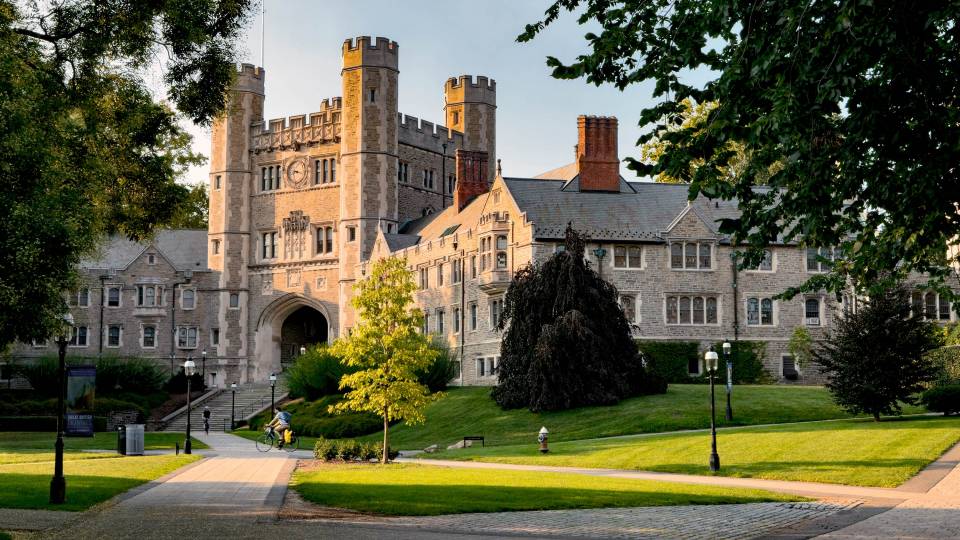A survey of Princeton researchers who returned this summer to on-campus laboratory-based activities found a high level of compliance with the University’s health and safety protocols.
The anonymous survey, conducted in late July, asked researchers to report how often they and their colleagues adhered to University guidelines on mask wearing, social distancing, laboratory density and other practices that help prevent transmission of the COVID-19 virus. Of the 818 people who took the survey, nearly all reported wearing a mask most or all of the time, maintaining 6 feet of distance between lab members, and following lab occupancy maximums.

Traffic patterns in laboratories have been adapted to maximize social distancing during the conduct of research.
“These results suggest that Princeton laboratory researchers are serious about safety,” said Dean for Research Pablo Debenedetti(Link is external), chair of the Committee on Phased Resumption of On-Campus Research(Link is external), which oversees pandemic-related policies affecting research personnel and facilities. “This level of adherence to health and safety guidelines is an encouraging sign that the University can carry out its research mission under uniquely challenging conditions.”
Princeton began in mid-June(Link is external) to employ a phased resumption(Link is external) of on-campus laboratory research, halted(Link downloads document) in March in response to the pandemic. As part of the resumption process, each faculty member in charge of a laboratory submitted a plan specifying how the lab would meet protocols established by the Office of Environmental Health and Safety(Link is external). In addition, academic departments created safety plans for shared scientific facilities and spaces such as restrooms, elevators and break rooms. Both sets of plans were carefully reviewed and, if found to be consistent with safety protocols, were approved by the Dean for Research.
The research resumption plans included the reconfiguration of work stations to ensure that individuals maintain 6 feet of distance from each other, sanitizing protocols for shared equipment and work spaces, and the creation of rotating schedules or work shifts, if needed to manage the number of people in a lab at any one time, so as to be consistent with a minimum area of 160 sq.ft. per researcher.
Robin Izzo(Link is external), executive director of Environmental Health and Safety, said that the response from the research community to the new guidelines has been very encouraging.
“Our research community has been nothing short of spectacular throughout the entire pandemic, from quickly shutting down laboratories in March to putting tremendous effort, time and detail into planning for the resumption of research,” said Izzo, a member of the Committee on Phased Resumption of On-Campus Research. “It’s one thing to write down what you are going to do. It’s another to put it into practice.”
The survey responses parallel the observations of Environmental Health and Safety staff, who conduct regular walk-throughs of the laboratories, Izzo said. “It is rare for them to find someone not following the protocols,” Izzo said. “People are being very thoughtful about the process.”
Princeton’s phased resumption plan prioritized the return of laboratory-based researchers, as their research cannot be done without using on-campus equipment. Any research that can be done remotely must be done remotely.
The researchers who took the survey include faculty, graduate students, and postdoctoral and staff researchers, primarily in the Natural Sciences and the School of Engineering and Applied Science.
Bonnie Bassler(Link is external), the Squibb Professor in Molecular Biology and chair of the Department of Molecular Biology, and a member of the Committee on Phased Resumption of On-Campus Research, said that the encouraging survey results are a positive signal for the eventual return of greater numbers of graduate students, postdoctoral and staff researchers, and faculty members.
“Our on-campus researchers are learning to navigate how we do research in a completely new mode, 6 feet apart, no interaction, no hanging out at a chalkboard, no looking over each other’s shoulder at the lab bench, which is how a lot of the exchange of ideas happens,” Bassler said. “On the plus side, in the midst of those constraints, researchers are developing a rhythm and adherence to these guidelines that is becoming more natural.”
Many respondents commented on how smoothly the resumption of research proceeded in June. In addition, a large number of respondents expressed their thanks for University leadership throughout the pandemic.
“My impression is that the return to research generally went very well,” said Richard Register(Link is external), professor of chemical and biological engineering, who, as the department’s acting chair during the summer, reviewed plans for faculty laboratories and for the department as a whole. “I think so far that Princeton has done a thoughtful and effective job of bringing back researchers, and the COVID-19 testing results will confirm this.”
Princeton launched a comprehensive asymptomatic COVID-19 testing program on Aug. 24. Regular asymptomatic testing is required for all University members approved to be on campus more than 8 hours per week. The third week of asymptomatic testing from Sept. 5 through Sept. 11 found only 3 positive tests among the 3,887 total tests administered. Weekly test results are published on the Fall 2020 website(Link is external).
The survey found that:
- 100% of respondents wear a mask most or all of the time on campus
- 94% of respondents adhere to the 6-feet distance requirement most or all of the time
- 98% of respondents adhere to the lab occupancy maximums most or all of the time
- 97% of respondents come to the lab only when feeling well
- 98% of respondents adhere to the lab access schedule all or most of the time
- Most researchers report a very high level of compliance by laboratory colleagues on all of the above
Although the survey found that compliance with health and safety protocols was high, it also revealed areas that need to be addressed.
- 4% of respondents reported they felt pressured to return to the lab and 6% said they felt pressured to work a schedule they weren’t comfortable working. Graduate students who experience problems with laboratory schedules should discuss the issue with their faculty adviser, or access resources(Link is external) outlined in the Plan for the Phased Resumption of On-campus Research.
- 4% of respondents said they sometimes or almost never followed routine cleaning and sanitizing procedures inside the lab, and some respondents commented that compliance was spotty, or that the procedures were cumbersome or unnecessary. Environmental Health and Safety(Link is external) staff is available to work with laboratories to address performance of necessary hygiene protocols.
- 32% reported at least one instance of encountering others who were not in compliance. Advice on encouraging compliance within the lab group is available in the Plan for the Phased Resumption of Research’s Environmental Health and Safety guidelines(Link is external). Researchers who wish to remain anonymous can report confidentially via the EthicsPoint(Link is external) hotline.
The Committee on Phased Resumption of On-Campus Research and the Office of Environmental Health and Safety are following up on these and other issues in need of improvement and attention with the goal of ensuring the health and safety of the campus community.






















